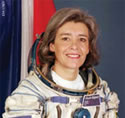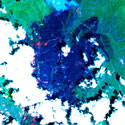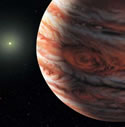NASA controllers decided to ground the shuttle fleet this week when they discovered tiny fuel line cracks. The first crack was uncovered during a routine examination of Atlantis, so the other shuttles were analyzed and additional cracks were found in Discovery as well. Industry experts applaud NASA’s decision to ground the fleet; since the Challenger disaster in 1986, NASA has put a greater emphasis on safety.
Open the pod bay door Universe Today
I think I’ve finally got everything working properly now, so I wanted to take moment and explain what happened Wednesday night (hereafter we’ll call it Evil Wednesday) when Universe Today took on a mind of its own and went on an email rampage. Around 8:00pm my time my Internet hosting provider started resending emails it had already sent through its mail system, including 12 versions of Universe Today. I contacted technical support and their only solution to stop this from happening was for me to delete the entire mailing list.
So I did (I had a backup). Then they recommended that I rebuild it again. So I did, which was when everyone on the list should have received a “Welcome to Universe Today” email. Don’t worry, you aren’t going to get an extra newsletter, you’re still just subscribed once. Unfortunately I think a few hundred people misunderstood, and unsubscribed from the newsletter. 🙁
My webhost accepted responsibility for the problem – it was totally their fault, not a virus, or problem on my end (whew). Unfortunately, they’re not entirely sure why it happened, but they’re still looking into it. So, there isn’t much I can do but hope that it doesn’t happen again.
Thanks for your support, here’s an adorable picture of my now 8-month old daughter to help distract you from the cramps in your delete finger.
Asteroid Narrowly Misses the Earth
An asteroid the size of a football field came extremely close to the Earth last week, and scientists didn’t even know until after it passed us by. Asteroid 2002 MN is 100 metres in diameter and passed by us at a distance of only 120,000km, less than one-third the distance from the Earth to the Moon. This is one of the closest near-misses ever recorded of a spacerock this size; had it actually struck the planet it would have cause considerable destruction and loss of life.
Endeavour Lands in California
After two extra days in space, Endeavour finally touched down at Edwards Air Force Base in California on Wednesday. The landing had been delayed because of thunderstorms at the Florida landing strip. During the shuttle’s 14 days in space, the astronauts delivered a new crew to the International Space Station and performed three spacewalks to install new hardware. The shuttle will now be mounted onto the back of a specially modified 747 and flown back to Florida to prepare for its next launch.
Endeavour in Space Another Day
Once again NASA postponed the landing of the space shuttle Endeavour because of foul weather in both Florida and California. The next opportunity will be on Wednesday, when the shuttle will try to land at Cape Canaveral at 1452 GMT (10:52am EDT). There’s one more window in Florida and three at California’s Edwards Air Force Base. The shuttle has enough supplies to remain in orbit until Thursday.
French Astronaut Gets Government Position

Image credit: ESA
Claudie Haigner?, an astronaut with the European Space Agency, has been appointed to the post of Minister for Research and New Technologies in the French government. She joined the European Astronaut Corps in 1999 and has been to space twice on board Russian Soyuz spacecraft – she was the first European woman to visit the International Space Station in 2001.
Claudie Haigner?, the ESA astronaut, has been appointed to the post of Minister for Research and New Technologies in the French government announced yesterday.
Claudie Haigner?, 45, with an outstanding ‘cursus honoris’, a doctor with a specialisation in rheumatology and a Ph.D in neurosciences, was selected in 1985 as a candidate astronaut by the French space agency, CNES. She has played a prominent role in the development of scientific applications of manned spaceflight and in fostering scientific relations with Russia. Mrs Haigner? is a permanent member of the French Academy of Technology and holds the honours of Officier de la L?gion d’Honneur and Chevalier de l’Ordre National du M?rite.
In 1999 she joined the European Astronaut Corps of the European Space Agency. She has taken part in two space missions with the Russians, ‘Cassiop?e’ in August 1996 and ‘Androm?de’ in October 2001. She was the first woman to qualify as a Soyuz Return Commander (July 1999), responsible for the three-person Soyuz capsule during a re-entry from space, and was the first European woman to visit the International Space Station (October 2001).
ESA’s Director General, Antonio Rodot?, expressed delight at this appointment, “In our ‘space world’ Claudie Haigner? has demonstrated really outstanding capabilities as a scientist as well as an astronaut during her time with us. This appointment honours the European Space Agency and puts Mrs Haigner? in a key position to shape the future of Europe’s science and technology. I wish her all the best in her new responsibilities.”
Original Source: ESA News Release
View of Colorado Fire from Space

Image credit: NASA
A new photo released from NASA’s Terra spacecraft shows the huge swath of destruction caused by the enormous fire in Colorado. The fire started on June 8, and has gone on to destroy more than 40,000 hectares. The image was acquired using Terra’s Advanced Spaceborne Thermal Emission and Reflection Radiometer (Aster), one of five Earth imaging instruments on board the spacecraft. This photo was taken on morning of Sunday, June 16.
Thousands of acres of burned vegetation, along with recent hotspots, are visible in a new image of Colorado’s worst forest fire taken by NASA’s Advanced Spaceborne Thermal Emission and Reflection Radiometer (Aster).
Started on June 8, the Hayman forest fire continues to burn in the Pike National Forest, 57 kilometers (35 miles) south-southwest of Denver, Colo. According to the U.S. Forest Service, the fire has consumed more than 100,000 acres.
The image is available at:
http://www.jpl.nasa.gov/images/earth/usa/west.html.
Acquired Sunday morning, June 16, 2002, the Aster image shows active fires in red. The dark blue area is burned vegetation, and the green areas are healthy vegetation. Clouds are white. The blue cloud at the top center is smoke. The image covers an area of 32.2 by 35.2 kilometers (20 by 21.8 miles).
Aster is one of five Earth-observing instruments launched in December 1999 on NASA’s Terra satellite. With its 14 spectral bands from the visible to the thermal infrared wavelength region and its high spatial resolution of 15 to 90 meters (about 50 to 300 feet), Aster will image Earth for the next six years to map and monitor the planet’s changing surface. Japan’s Ministry of Economy, Trade and Industry built the instrument. NASA’s Jet Propulsion Laboratory, Pasadena, Calif., is responsible for the American portion of the joint U.S./Japan science team that validates and calibrates the instrument and the data products.
Original Source: NASA/JPL News Release
Write Your Name on an Asteroid?
A Japanese spacecraft will give people an opportunity to land their name on an asteroid. Due for launch near the end of this year, the MUSES-C spacecraft will meet up with asteroid 1998 SF36 when it crosses the Earth’s orbit in 2005. It will land on the asteroid, collect samples which it will later return to Earth. As part of its mission, the spacecraft will deposit an aluminium foil sheet containing the names of hundreds of thousands of space enthusiasts. If you want to get your name on board, you have until July 5th.
Thunderstorms Delay Shuttle Landing
Flight controllers decided to wave two landing attempts of the space shuttle Endeavour on Monday because of thunderstorms threatening the Cape Canaveral landing area. The shuttle will try again on Tuesday, but forecasters are predicting poor weather then too. Alternatively, the shuttle can land at Edward’s Air Force Base in California; however, it’s a more expensive option as Endeavour will need to be returned to Florida. The first landing attempt on Tuesday is scheduled for 1555 GMT (11:55am EDT).
New Planetary System has Familiar Feel

Image credit: NASA
Planet hunters have discovered a new extrasolar system that looks remarkable like our own Solar System. Until now, planets orbiting around other stars have had elongated and eccentric orbits, but a planet orbiting around 55 Cancri has almost the same distance as our own Jupiter (although, it does have 3.5-5 times the mass). The team of astronomers also announced an additional 13 new planets on the same day, bringing the total number of known planets outside our Solar System to over 90.
After 15 years of observation and a lot of patience, the world’s premier planet-hunting team has finally found a planetary system that reminds them of our own home solar system.
Dr. Geoffrey Marcy, astronomy professor at the University of California, Berkeley, and astronomer Dr. Paul Butler of the Carnegie Institution of Washington, Washington, D.C., today announced the discovery of a Jupiter-like planet orbiting a Sun-like star at nearly the same distance as the Jovian system orbits our Sun.
“All other extrasolar planets discovered up to now orbit closer to the parent star, and most of them have had elongated, eccentric orbits. This new planet orbits as far from its star as our own Jupiter orbits the Sun,” said Marcy. NASA and the National Science Foundation fund the planet-hunting team.
The star, 55 Cancri in the constellation Cancer, was already known to have one planet, announced by Butler and Marcy in 1996. That planet is a gas giant slightly smaller than the mass of Jupiter and whips around the star in 14.6 days at a distance only one-tenth that from Earth to the Sun.
Using as a yardstick the 93-million mile Earth-Sun distance, called an astronomical unit or AU, the newfound planet orbits at 5.5 AU, comparable to Jupiter’s distance from our Sun of 5.2 AU (about 824 million kilometers or 512 million miles). Its slightly elongated orbit takes it around the star in about 13 years, comparable to Jupiter’s orbital period of 11.86 years. It is 3.5 to 5 times the mass of Jupiter.
“We haven’t yet found an exact solar system analog, which would have a circular orbit and a mass closer to that of Jupiter. But this shows we are getting close, we are at the point of finding planets at distances greater than 4 AU from the host star,” said Butler. “I think we will be finding more of them among the 1,200 stars we are now monitoring.”
The team shared its data with Dr. Greg Laughlin, assistant professor of astronomy and astrophysics at the University of California, Santa Cruz. His dynamical calculations show that an Earth-sized planet could survive in a stable orbit between the two gas giants. For the foreseeable future, existence of any such planet around 55 Cancri will remain speculative.
“The existence of analogs to our solar system adds urgency to missions capable of detecting Earth-sized planets – first the Space Interferometry Mission and then the Terrestrial Planet Finder,” said Dr. Charles Beichman, NASA’s Origins Program chief scientist at the agency’s Jet Propulsion Laboratory, Pasadena, Calif.
“This planetary system will be the best candidate for direct pictures when the Terrestrial Planet Finder is launched later this decade,” said UC Berkeley astronomer Dr. Debra A. Fischer.
Marcy, Butler, Fischer and their team also announced a total of 13 new planets today, including the smallest ever detected: a planet circling the star HD49674 in the constellation Auriga at a distance of .05 AU, one-twentieth the distance from Earth to the Sun. Its mass is about 15 percent that of Jupiter and 40 times that of Earth. This brings the number of known planets outside our solar system to more than 90.
Discovery of a second planet orbiting 55 Cancri culminates 15 years of observations with the 3-meter (118-inch) telescope at Lick Observatory, owned and operated by the University of California. The team also includes Dr. Steve Vogt, University of California, Santa Cruz; Dr. Greg Henry, Tennessee State University, Nashville; and Dr. Dimitri Pourbaix, the Institut d’Astronomie et d’Astrophysique, Universit? Libre de Bruxelles.
The star 55 Cancri is 41 light years from Earth and is about 5-billion years old. Further data are needed to determine whether yet another planet is orbiting it, because the two known planets do not explain all the observed Doppler wobbling. One possible explanation is a Saturn-mass planet orbiting about .24 AU from the star.
Original Source: NASA/JPL News Release
